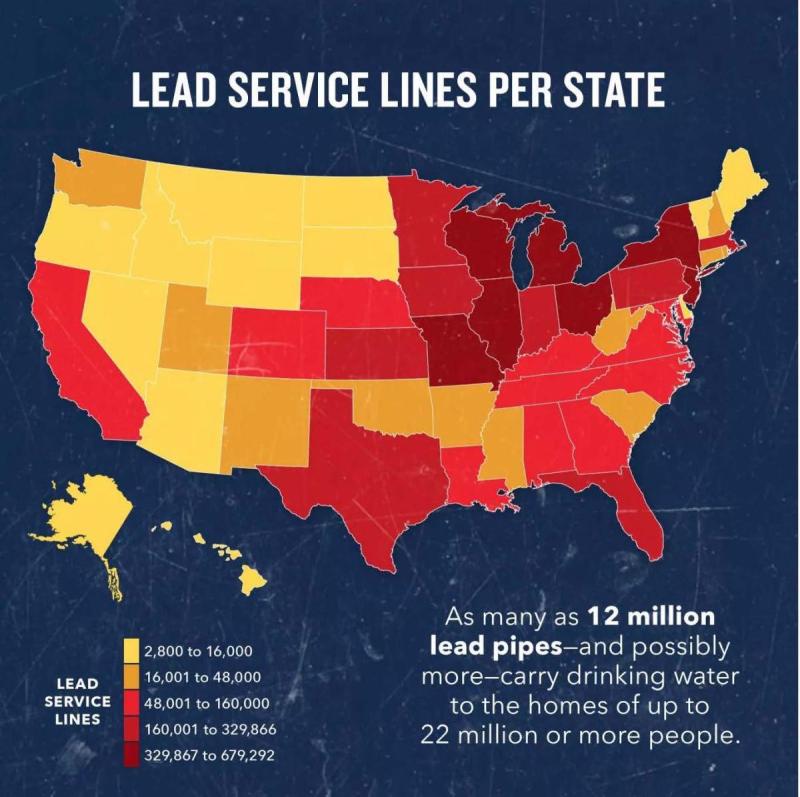Lead Service Line (LSL) Inventory & Replacement Project
THIS PAGE IS UNDER CONSTRUCTION
Welcome to the Lead Service Line Inventory and Replacement Project site!
This section covers the general context, scope, and intent of this project, contact information for project personnel, and educational information about the service line identification and replacement process.
Select the following link to review the Lead Service Line Inventory Program Fact Sheet prepared by MassDEP.
A Brief History of Lead in Water Infrastructure and its Impacts
Lead has been utilized in water infrastructure for thousands of years, including by the Romans, due to its malleability, availability, and ease with being joined to other pipes. Even as far back as 2 BC, however, physicians were already documenting lead toxicity and poisoning; regardless, people continued to utilize lead in a variety of ways, including as a wine preservative and sweetener, paint additive, key element in metalwork and glasswork, etc. This led to numerous debates amongst chemists, physicians, engineers, and government officials about the impacts of lead exposure and whether it should be regulated.
For additional details and historical artifacts, please visit the digital National Library of Medicine.
Despite such long-standing suspicions of the negative effects of lead exposure, including birth defects and developmental disabilities, the United States continued to allow its use in drinking water infrastructure until its ban by Congress in 1986; however, this ban only covered the installation of lead pipes and did not require the removal of existing lead infrastructure.
Originally published in 1991 and subsequently revised as recently as 2021, the Environmental Protection Agency (EPA)-mandated Lead and Copper Rule allows public water systems (PWSs) to better control lead and copper concentrations in water and identify where lead water service lines exist across the United States. Under this rule (specifically §141.84), every PWS is required to submit a verified water service line inventory. Figure 1 provides an estimate of suspected lead services lines across the nation per a survey performed by the Natural Resources Defense Council (NRDC):

Figure 1: Estimated Lead Services Lines per State (source: https://www.nrdc.org/stories/causes-and-effects-lead-water)
In an effort to continue making progress with prioritizing the public health and safety of Americans, the White House released a public briefing on December 16th, 2021, with the following statement:
“Today, the Biden-Harris Administration is releasing its Lead Pipe and Paint Action Plan. The plan represents a historic effort of unprecedented ambition that will deploy catalytic resources from the Bipartisan Infrastructure Law while leveraging every tool across federal, state, and local government to deliver clean drinking water, replace lead pipes, and remediate lead paint. The plan includes over 15 new actions from more than 10 federal agencies that ensure the federal government is marshalling every resource to make rapid progress towards replacing all lead pipes in the next decade.”
Source: The White House FACT SHEET: The Biden-Harris Lead Pipe and Paint Action Plan
The EPA and Massachusetts Department of Environmental Protection (Mass DEP) are providing training sessions, guidance, and many other resources to help PWSs identify and eliminate lead in the distribution system.
Project Context and Purpose
The ultimate goal of this project is to develop an accurate inventory comprised of verified lead and galvanized water service lines (Phase I) for the purpose of providing it to the public and informing the Uxbridge system users of which services will need to be replaced (Phase II). The Water Division will continue to replace public lead service lines as discovered during normal operations; additionally, the Water Division maintains a robust corrosion control program using polyphosphate to reduce lead concentration throughout the water system. This treatment process ensures that your water is well in compliance with relevant state and federal water quality regulations.
The EPA provides guidance to PWSs to reduce lead in drinking water by complying with federal and state regulations with the ultimate goal of complete lead removal from the distribution system; as displayed in Figure 2, this includes providing educational materials to the public, maintaining a useful lead and copper sampling program, keeping appropriate records, communicating with the public about this project, and remediating the presence of lead in water.

Figure 2: 3Ts for Reducing Lead in Drinking Water (source: https://www.epa.gov/ground-water-and-drinking-water/3ts-reducing-lead-drinking-water)
Phase I: Inventory Verification
During this phase, Water Division staff in concert with our consultant will continue to verify the division’s records through review of readily available data and on-site inspections.
Phase II: Service Line Replacement
TBD-UNDER CONSTRUCTION
Project Specifics, FAQs, and Educational Information
Where can I get more information about this initiative?
The notice distributed to PWSs may be found here:
https://www.mass.gov/doc/getting-ready-for-the-lead-and-copper-rule-revisions-lead-service-line-inventories/download
More specific information about the Lead and Copper Rule and its revisions may be found here: https://www.epa.gov/dwreginfo/lead-and-copper-rule
More specific information about the water service line material verification directives may be found here:
https://www.epa.gov/ground-water-and-drinking-water/revised-lead-and-copper-rule
The EPA’s response to the White House’s December 2021 statement may be found here:
https://www.epa.gov/newsreleases/epa-issues-guidance-help-communities-locate-lead-pipes-can-contaminate-drinking-water
How do I get a lead test for my water?
https://www.mass.gov/how-to/find-a-certified-laboratory-for-water-testing provides a list of certified labs; tests typically cost under $50.
You may also opt to contact the Mass DEP Drinking Water Program representative at (617) 292-5770 or program.director-dwp@mass.gov for additional information regarding finding a certified lab.
Who should I contact if I have questions?
The Water Division is pleased to provide any information related to this project between the hours of 7 am to 3 pm, Monday through Friday. For any questions you may have, please contact the DPW Administration office at (508) 278-8616 Your feedback and mutual open communication are critical to the success of this project.
You may also contact the Mass DEP Drinking Water Program representative at (617) 292-5770 or program.director-dwp@mass.gov.
